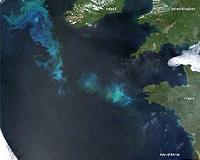| . |  |
. |
Washington DC (SPX) Jul 20, 2010 The size and number of marine dead zones-areas where the deep water is so low in dissolved oxygen that sea creatures can't survive-have grown explosively in the past half-century. Red circles on this map show the location and size of many of our planet's dead zones. Black dots show where dead zones have been observed, but their size is unknown. It's no coincidence that dead zones occur downriver of places where human population density is high (darkest brown). Some of the fertilizer we apply to crops is washed into streams and rivers. Fertilizer-laden runoff triggers explosive planktonic algae growth in coastal areas. The algae die and rain down into deep waters, where their remains are like fertilizer for microbes. The microbes decompose the organic matter, using up the oxygen. Mass killing of fish and other sea life often results. Satellites can observe changes in the way the ocean surface reflects and absorbs sunlight when the water holds a lot of particles of organic matter. Darker blues in this image show higher concentrations of particulate organic matter, an indication of the overly fertile waters that can culminate in dead zones. Naturally occurring low-oxygen zones are regular features in some parts of the ocean. These coastal upwelling areas, which include the Bay of Bengal and the Atlantic west of southern Africa, are not the same as dead zones because their bottom-dwelling marine life is adapted to the recurring low-oxygen conditions. However, these zones may grow larger with the additional nutrient inputs from agricultural runoff.
Share This Article With Planet Earth
Related Links Earth Observatory Water News - Science, Technology and Politics
 Findings Overturn Old Theory Of Phytoplankton Growth
Findings Overturn Old Theory Of Phytoplankton GrowthCorvallis OR (SPX) Jul 20, 2010 A new study concludes that an old, fundamental and widely accepted theory of how and why phytoplankton bloom in the oceans is incorrect. The findings challenge more than 50 years of conventional wisdom about the growth of phytoplankton, which are the ultimate basis for almost all ocean life and major fisheries. And they also raise concerns that global warming, rather than stimulating ocean ... read more |
|
| The content herein, unless otherwise known to be public domain, are Copyright 1995-2010 - SpaceDaily. AFP and UPI Wire Stories are copyright Agence France-Presse and United Press International. ESA Portal Reports are copyright European Space Agency. All NASA sourced material is public domain. Additional copyrights may apply in whole or part to other bona fide parties. Advertising does not imply endorsement,agreement or approval of any opinions, statements or information provided by SpaceDaily on any Web page published or hosted by SpaceDaily. Privacy Statement |